The Ordinary lactic acid serums are two The Ordinary products that provide rather quick visible results and can be purchased at very low prices (see my complete review here).
The Ordinary offers two different strength lactic acid serums: one at a 5% concentration and the other at a 10% concentration. Since exfoliating acids can be irritating to the skin, you might be wondering how to use lactic acid serums from The Ordinary.

Today we’ll be discussing how to use The Ordinary lactic acid serums and how to easily incorporate them into your skincare routine.
This post contains affiliate links, and any purchases made through these links will result in a commission for me at no extra cost to you. Please read my Disclosure for additional information.
How To Use The Ordinary Lactic Acid in Your Skincare Routine
The first thing to note about these lactic acid serums is that you should not use them on sensitive, peeling or compromised skin.
So if your skin is sensitive, easily irritated, or damaged in any way, you should not use these serums.
Alpha hydroxy acids can make your skin sensitive to the sun, so it is important to apply a broad-spectrum sunscreen with an SPF of 30 or higher while using lactic acid (and all alpha-hydroxy acids) and for a week after.
These lactic acid serums may be diluted with other skincare treatments to reduce their concentration until your skin can tolerate them undiluted.
An easy way to dilute them is to mix a drop or two into a few drops of The Ordinary Hyaluronic Acid 2% + B5 Serum.
How Often To Use Lactic Acid in Your Skincare Routine
First choose a lactic acid concentration: The Ordinary Lactic Acid 5% + HA or The Ordinary Lactic Acid 10% + HA.
If you are new to acids, start out using The Ordinary lactic acid serum once a week. See how your skin responds and slowly increase usage as your skin builds a tolerance.
While you can use the lactic acid serum daily, most can get good results using lactic acid 2 or 3 times a week. Try to use it in the evening if possible.
The Ordinary recommends patch testing before using their lactic acid serums and any new product. For additional details on patch testing, please see their patch testing guide.
When To Use The Ordinary Lactic Acid Serums in Your Skincare Routine
These water-based lactic acid serums should be applied during the treatment step of your skin routine, which is after cleansing and toning, but before other serums and moisturizers.
Related Post: How to Build A Skincare Routine with The Ordinary Products
What Not to Mix with The Ordinary Lactic Acid Serums
Since lactic acid is potentially sensitizing, you should not use it at the same time as other direct acids like salicylic acid or azelaic acid, other AHAs like glycolic acid or mandelic acid, or other actives like benzoyl peroxide acne treatments.
You should also avoid using lactic acid with strong actives like pure vitamin C (ascorbic acid). Ascorbic acid works best at a pH of 3.5 or under.
The Ordinary lactic acid serums are formulated at a pH of 3.6 – 3.8.
While the lactic acid pH should be close enough not to compromise the effectiveness of ascorbic acid, you may experience redness, stinging, peeling, or irritation if you use both ascorbic acid and lactic acid at the same time.
Your best bet is to use ascorbic acid in the morning and lactic acid in the evening or use them on different days.
Retinol and retinoids increase cellular turnover and remove dead skin cells.
Since lactic acid also works to sweep away dead skin cells, you may overdo it, causing irritation and redness if you use both simultaneously.
Additionally, the pH of retinol is higher than acidic lactic acid, so using them together may render both much less effective.
These lactic acid serums conflict with peptides like The Ordinary Multi-Peptide + HA Serum (formerly known as The Ordinary “Buffet”) or The Ordinary “Buffet” with Copper Peptides since the low pH of lactic acid may compromise the effectiveness of the peptide products.
The Ordinary also notes that their lactic acid serums are not compatible with their EUK 134 0.1% antioxidant serum, 100% Niacinamide Powder, other direct acids, pure/ethylated vitamin C, and retinol/retinoids.
Please see my The Ordinary Conflicts (With PDF) post for a complete list of The Ordinary conflicts. Learn more about all The Ordinary exfoliating acids in this comprehensive guide.
The Ordinary Lactic Acid 5% + HA
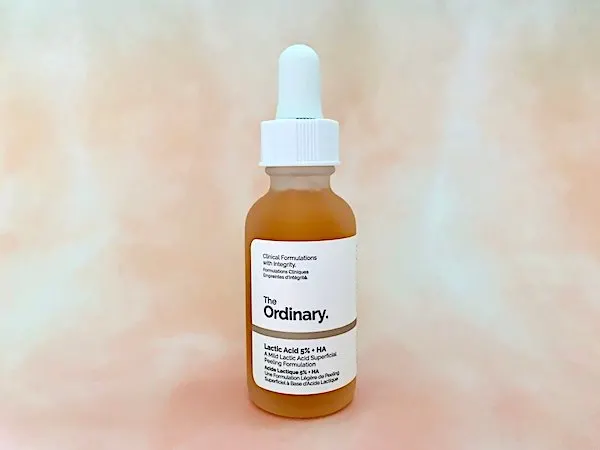
The Ordinary Lactic Acid 5% + HA is an alpha hydroxy acid serum and mild superficial peeling formula that exfoliates the skin. This is the milder of the two The Ordinary lactic acid serums, as it contains 5% lactic acid.
The serum contains a purified Tasmanian pepperberry derivative to help offset the irritation that often comes along with chemical exfoliation.
This lactic acid serum also contains sodium hyaluronate crosspolymer, a cross-linked type of hyaluronic acid with even better moisture-retention abilities than traditional hyaluronic acid.
It forms a film on the skin’s surface that delivers moisture over an extended period of time compared to regular hyaluronic acid. Glycerin, a humectant, is included for additional moisture.
Both The Ordinary lactic acid serums are formulated at a pH between 3.60 – 3.80. This is important because lactic acid has a pKa of 3.8. PKa denotes acid availability.
So when pH and pKa are close, salt and acidity are in balance, and the formula will reach prime effectiveness with minimum irritation.
This low 5% concentration lactic acid product is a great option for those new to acids and for those with sensitive skin.
It gently exfoliates while hydrating and moisturizing the skin with glycerin and hyaluronic acid.
The Ordinary Lactic Acid 5% + HA Ingredients: Aqua (Water), Lactic Acid, Glycerin, Pentylene Glycol, Propanediol, Sodium Hyaluronate Crosspolymer, Tasmannia Lanceolata Fruit/Leaf Extract, Acacia Senegal Gum, Xanthan Gum, Isoceteth-20, Trisodium Ethylenediamine Disuccinate, Sodium Hydroxide, Ethylhexylglycerin, 1,2-Hexanediol, Caprylyl Glycol.
The Ordinary Lactic Acid 10% + HA
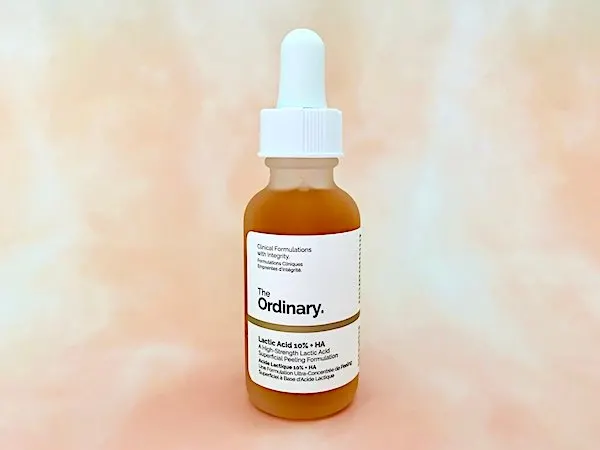
The Ordinary Lactic Acid 10% + HA contains a 10% concentration of lactic acid to exfoliate the skin. It contains a purified Tasmanian pepperberry derivative which helps calm irritation and sensitivity that comes along with direct acids like lactic acid.
This serum also contains moisturizing glycerin and sodium hyaluronate crosspolymer to hydrate and plump the skin.
This is a mild exfoliating acid that helps to brighten the skin and even out skin tone while improving skin clarity.
If your skin does not build a tolerance to this 10% formula and you continue to experience irritation, redness, and stinging, you may want to consider The Ordinary Lactic Acid 5% + HA or The Ordinary Mandelic Acid 10% + HA, which AHA formulas that provide a gentle exfoliation.
For a comparison of lactic acid and mandelic acid, please see my post on The Ordinary Mandelic Acid vs Lactic Acid.
The Ordinary Lactic Acid 10% + HA Ingredients: Aqua (Water), Lactic Acid, Glycerin, Pentylene Glycol, Propanediol, Sodium Hydroxide, Sodium Hyaluronate Crosspolymer, Tasmannia Lanceolata Fruit/Leaf Extract, Acacia Senegal Gum, Xanthan Gum, Isoceteth-20, Trisodium Ethylenediamine Disuccinate, Ethylhexylglycerin, 1,2-Hexanediol, Caprylyl Glycol.
The Ordinary Lactic Acid 5% + HA vs The Ordinary Lactic Acid 10% + HA
Both The Ordinary Lactic Acid 5% + HA and The Ordinary Lactic Acid 10% + HA are effective exfoliating alpha hydroxy acid treatments.
The Ordinary Lactic Acid 5% + HA is a great choice for beginners and those with sensitive skin.
I see more immediate results with The Ordinary Lactic Acid 10% + HA, but you choose 5% or 10% based on your skin type and skin concerns.

The serums are very similar in appearance. The Ordinary Lactic Acid 10% + HA (on the right) is slightly darker in shade than The Ordinary Lactic Acid 5% + HA.
The Ordinary Lactic Acid vs Glycolic Acid 7% Toning Solution
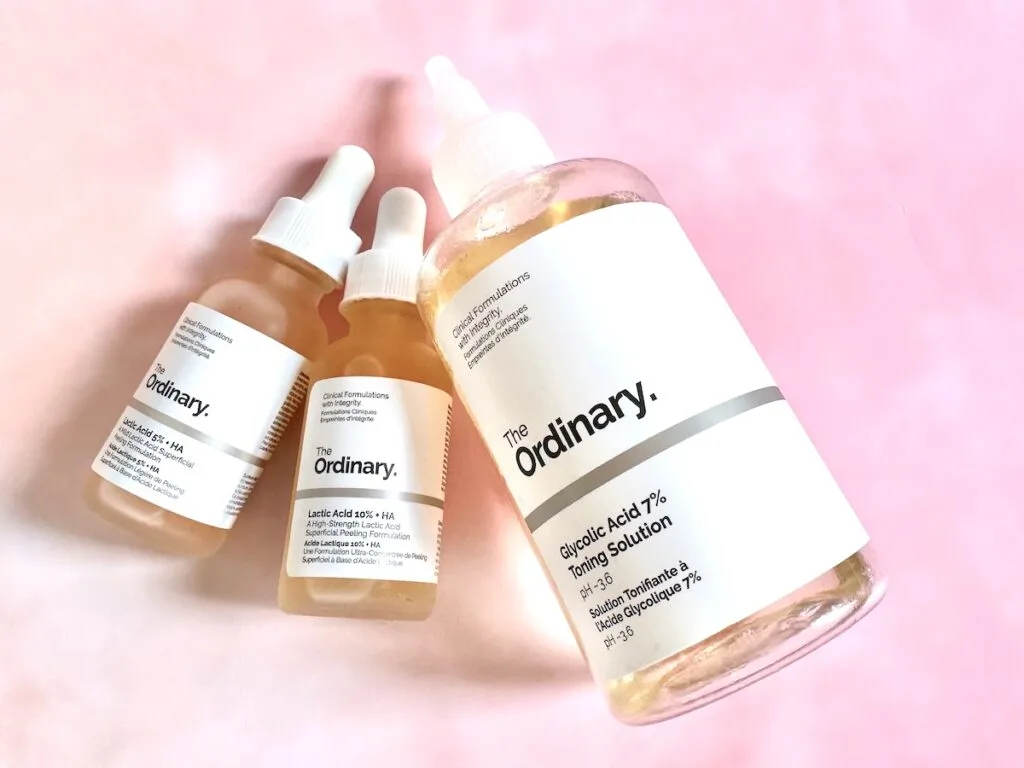
| The Ordinary Lactic Acid Serums | Glycolic Acid 7% Toning Solution | |
|---|---|---|
| Key Ingredients | 5% lactic acid or 10% lactic acid | 7% glycolic acid |
| Benefits | ✅ Exfoliates the surface of your skin ✅ Less irritating than glycolic acid ✅ Offers moisturizing benefits | ✅ Exfoliates the surface of your skin ✅ The most potent alpha hydroxy acid (AHA) ✅ Offers moisturizing benefits |
| Drawbacks | Less effective than glycolic acid | May cause irritation |
While glycolic acid and lactic acid are both alpha hydroxy acids(AHAs) that resurface the outer layer of your skin for a brighter, smoother complexion, they differ in their potency and properties.
Lactic acid is slightly less potent than glycolic acid, meaning that you may need to apply it more frequently to achieve the same results. Due to its smaller molecule size, glycolic acid may cause more irritation than lactic acid.
Key Ingredients: Concentration
The Ordinary’s Lactic Acid serums are available in two concentrations: 5% and 10%, so the 10% concentration is twice as potent as the 5%.
The Ordinary Glycolic Acid 7% Toning Solution contains 7% glycolic acid.
Properties and Benefits
Lactic acid, which is an alpha hydroxy acid (AHA), works to gently exfoliate the skin. It aids in refining skin texture and enhancing brightness. It can also offer some hydrating and moisturizing properties.
Glycolic acid is another AHA that has a smaller molecular size compared to lactic acid, allowing it to penetrate the skin more deeply.
This quality makes it particularly effective in exfoliating, reducing the appearance of fine lines, and improving skin texture and tone. Glycolic acid also offers some moisturizing benefits for your skin.
The Ordinary Lactic Acid vs Glycolic Acid: Which Should You Use?
- The Ordinary’s 5% lactic acid concentration is ideal for those who are new to AHAs or have more sensitive skin.
- The 10% lactic acid serum, being more potent, is better suited to those who have previously used AHAs or have less sensitive skin.
- While Glycolic Acid 7% Toning Solution is designed for most skin types, its 7% strength means that those new to glycolic acid should use it with caution.
- If your skin can tolerate it, The Ordinary glycolic acid toner is an excellent option if you want a potent daily exfoliant.
Remember to always patch test before using either product on your face, as this can help prevent potential adverse reactions.
It bears mentioning again that when using alpha hydroxy acids, be sure to protect your skin from the sun by always wearing a broad-spectrum sunscreen with an SPF of 30 or higher, as AHAs can make your skin more sensitive to UV radiation.
Related Post: How To Use The Ordinary Glycolic Acid
The Ordinary Lactic Acid vs AHA 30% + BHA 2% Peeling Solution
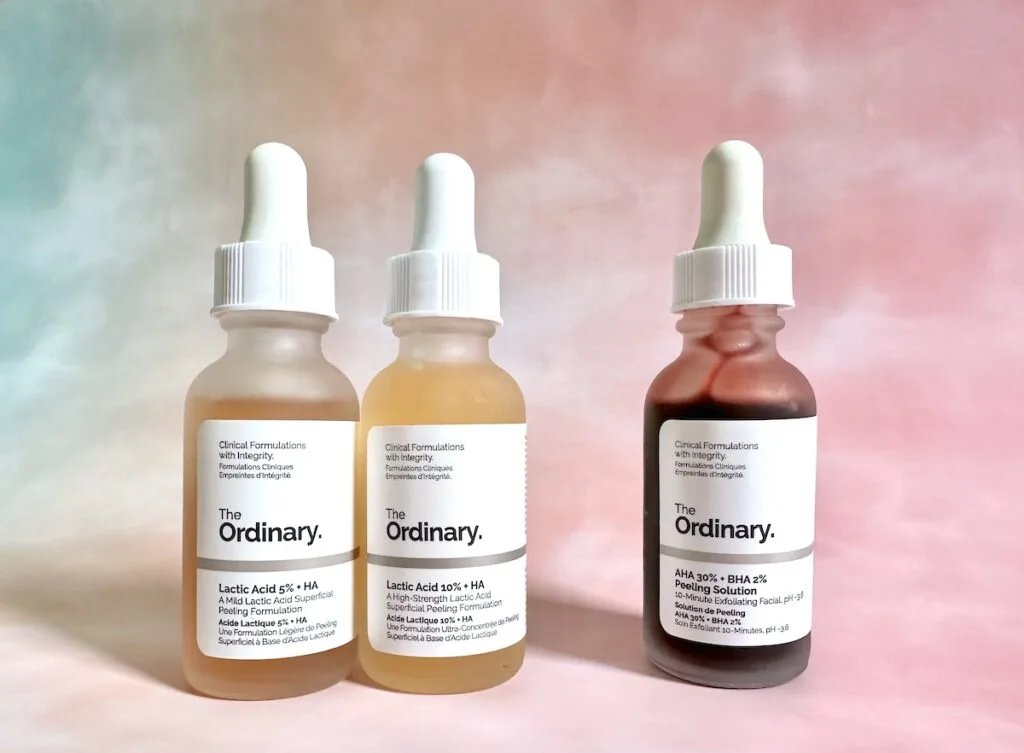
| The Ordinary Lactic Acid Serums | The Ordinary AHA 30% + BHA 2% Peeling Solution | |
|---|---|---|
| Key Ingredients | 5% lactic acid or 10% lactic acid | 30% AHAs (glycolic acid, lactic acid, tartaric acid, and citric acid) and 2% BHA (salicylic acid) |
| Benefits | ✅ Exfoliates the surface of your skin ✅ Much less irritating than AHA 30% + BHA 2% Peeling Solution ✅ Offers moisturizing benefits | ✅ Exfoliates the surface of your skin and inside your pores ✅ Potent AHA and BHA concentration ✅ Can help with acne and breakouts |
| Drawbacks | Less effective than glycolic acid; Doesn’t target clogged pores | Not for sensitive skin and ONLY for experienced acid users; May cause irritation |
The Ordinary lactic acid serums and The Ordinary AHA 30% + BHA 2% Peeling Solution are quite different products.
The Ordinary Peeling Solution contains a VERY high concentration of AHAs and BHAs, so it should only be used by experienced users of acid exfoliation. I can’t emphasize that enough!
Key Ingredients: Concentration
The Ordinary offers Lactic Acid in two concentrations: 5% and 10%. The Ordinary AHA 30% + BHA 2% Peeling Solution combines a 30% concentration of alpha hydroxy acids (glycolic acid, lactic acid, tartaric acid, and citric acid) with a 2% concentration of beta hydroxy acid (salicylic acid).
The 30% concentration of AHAs is not broken down by acid type, although it is safe to say that there is a higher concentration of glycolic acid than any of the other AHAs since glycolic acid is the most concentrated ingredient in the acid toner.
Properties and Benefits
Lactic acid provides a gentler exfoliation, targeting the surface of the skin to refine texture and enhance radiance while moisturizing your skin.
The AHA 30% + BHA 2% Peeling Solution is a much more intensive exfoliating treatment.
The AHAs in this peeling solution exfoliate your skin’s surface, while the BHA penetrates deeper to unclog pores and target blemishes. This combination makes the peeling solution effective for both texture and acne concerns.
NOTE: The Ordinary lactic acid serums are leave on products. The 5% or 10% serum, depending on your tolerance, can be used daily. The Ordinary AHA 30% + BHA 2% Peeling Solution is a rinse-off mask with a blood-red liquid texture.
The peeling solution shouldn’t be left on your skin for more than 10 minutes and should be used no more than once or twice a week.
The Ordinary Lactic Acid vs AHA 30% + BHA 2% Peeling Solution: Which Should You Use?
Your choice between The Ordinary’s Lactic Acid and the AHA 30% + BHA 2% Peeling Solution should be based on your skin’s needs and tolerance.
- If you’re new to acids or have sensitive skin, be sure to start with lactic acid due to its milder properties.
- For experienced acid users looking for a more intensive treatment and those who can tolerate it, The Ordinary AHA 30% + BHA 2% Peeling Solution may be a better choice, especially if you have acne, acne scars, or uneven skin texture.
The Ordinary Lactic Acid vs Mandelic Acid 10% + HA
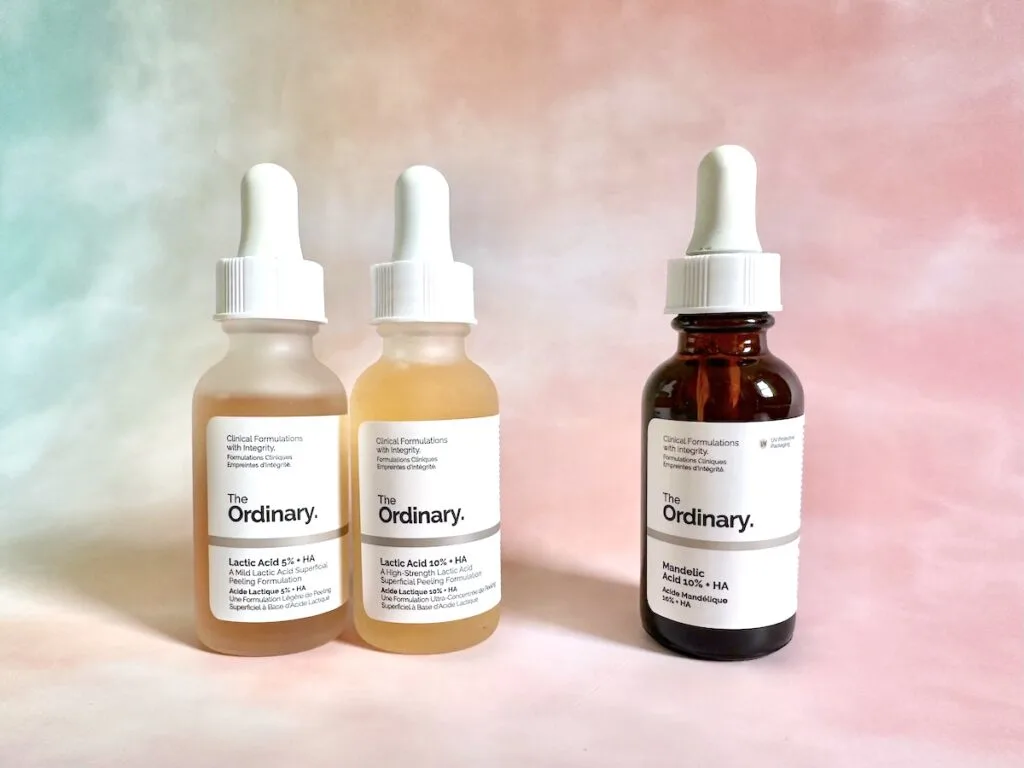
| The Ordinary Lactic Acid Serums | The Ordinary Mandelic Acid 10% + HA | |
|---|---|---|
| Key Ingredients | 5% lactic acid or 10% lactic acid | 10% mandelic acid |
| Benefits | ✅ Exfoliates the surface of your skin ✅ Offers moisturizing benefits | ✅ Exfoliates the surface of your skin ✅ Offers anti-inflammatory and antibacterial properties ✅ Can help with acne and breakouts ✅ May appeal to sensitive skin types |
| Drawbacks | Higher concentrations may irritate sensitive skin; Not as potent as glycolic acid | Not as effective as lactic acid |
Key Ingredients: Concentration
While The Ordinary’s Lactic Acid comes in 5% and 10% concentrations, The Ordinary Mandelic Acid 10% + HA comes in a single 10% concentration.
Properties and Benefits
Lactic acid exfoliates your skin’s surface, enhances radiance, and improves texture. Its moisturizing properties make it beneficial for drier skin types.
Mandelic acid is also an alpha hydroxy acid and has a larger molecular size than lactic acid. This means it penetrates the skin more slowly, making it even gentler and less irritating.
Due to its anti-inflammatory and antibacterial properties, it’s especially effective for those with acne-prone or sensitive skin.
The Ordinary Lactic Acid vs Mandelic Acid: Which Should You Use?
Choosing between The Ordinary’s Lactic Acid and Mandelic Acid depends on your skin type and concerns.
- If you have drier skin, The Ordinary Lactic Acid serums might be the better choice.
- If you have more sensitive or acne-prone skin, Mandelic Acid 10% can offer gentle exfoliation without worsening inflammation or triggering breakouts.
Read more about these two acids in my The Ordinary Lactic Acid vs Mandelic Acid post.
The Ordinary Lactic Acid vs Good Genes
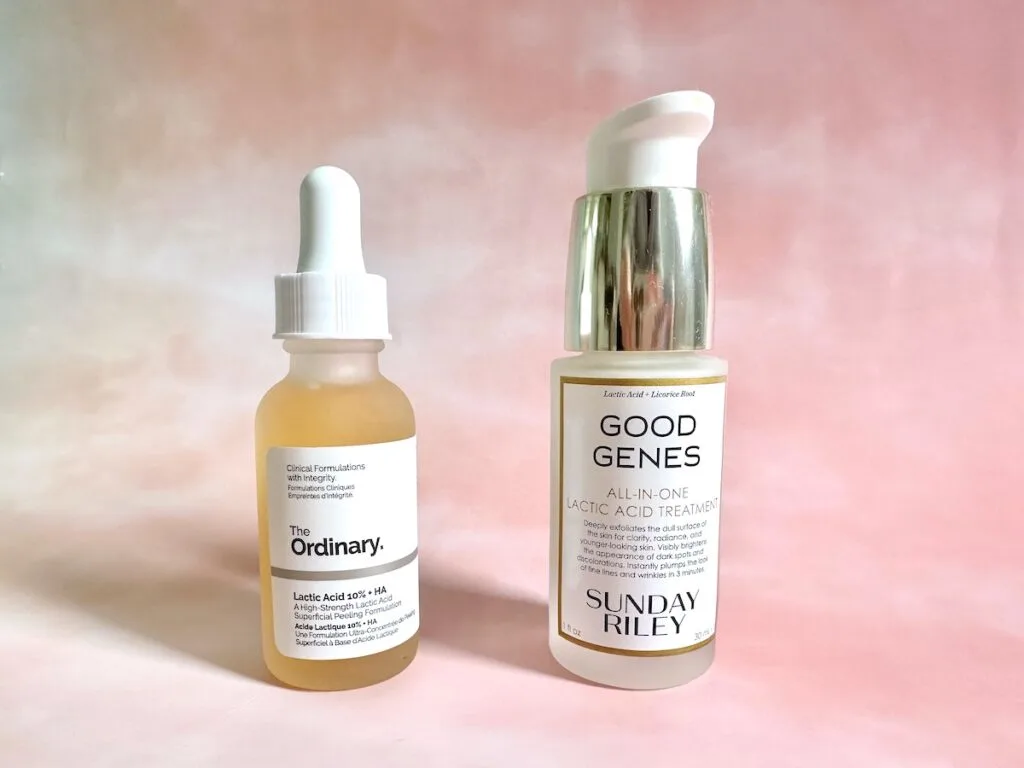
| The Ordinary Lactic Acid Serums | Sunday Riley Good Genes | |
|---|---|---|
| Key Ingredients | 5% lactic acid or 10% lactic acid | Lactic acid (concentration not disclosed), licorice, lemongrass |
| Benefits | ✅ Exfoliates the surface of your skin ✅ Offers moisturizing benefits | ✅ Exfoliates the surface of your skin ✅ More potent than The Ordinary lactic acid products ✅ May help with dark spots |
| Drawbacks | Higher concentrations may irritate sensitive skin; Not as potent as glycolic acid | Much more expensive than The Ordinary; May irritate sensitive skin |
Key Ingredients: Concentration
The Ordinary offers Lactic Acid in two concentrations: 5% and 10%.
Sunday Riley Good Genes All-In-One Lactic Acid Treatment is primarily formulated with lactic acid, but the exact concentration of lactic acid and other active ingredients isn’t disclosed by the brand. (Please note that it’s widely considered a high-potency formula.)
The Ordinary vs Good Genes: Properties and Benefits
The Ordinary’s lactic acid serums work to shed dead skin cells, brighten your complexion, and improve your skin texture. They also have hydrating properties, which can be particularly beneficial for those with drier skin types.
Good Genes, while also containing lactic acid for exfoliation, is formulated with a mix of other beneficial ingredients like licorice and lemongrass, which can aid in reducing dark spots and improving overall radiance.
The combination makes it more than just an exfoliating treatment – it’s designed to be a comprehensive skin-brightening and plumping solution.
The Ordinary Lactic Acid vs Good Genes: Which Should You Use?
Your choice between The Ordinary’s Lactic Acid and Good Genes will depend on your skincare goals and budget:
- If you’re looking for a straightforward lactic acid treatment, The Ordinary offers two affordable options.
- If you’re in search of a multi-tasking product with a broader range of benefits and are willing to invest a bit more, Good Genes might be the better choice.
Although pricey, I’ve used Good Genes for several years and continue to love the results.
Related Post: The Best Good Genes Dupes
What is Lactic Acid?
Found naturally in sour milk and synthetically produced for skincare products, lactic acid is an alpha hydroxy acid (AHA) that acts as a chemical exfoliant to sweep away dead skin cells on the surface of the skin
It improves dark spots, uneven skin tone, and skin texture while brightening dull skin.
It also helps to smooth the appearance of the skin and reduce the look of wrinkles and fine lines.
Lactic acid is a good choice if you want an effective chemical exfoliant that isn’t too strong or irritating.
Lactic acid has a larger molecule size than glycolic acid, a more potent alpha hydroxy acid, so lactic acid tends to create less skin irritation, tingling, and redness than a stronger AHA like glycolic acid.
Lactic Acid: Great for Most Skin Types
Lactic acid is a popular skincare exfoliant because it works well for most skin types. It helps to smooth fine lines and wrinkles on aging/mature skin.
Lactic acid can help open clogged pores and help reduce acne lesions, making it a good choice for oily and acne-prone skin types.
Lactic acid also has moisturizing properties, which makes it a good option as a mild exfoliant for those with dry skin.
Depending on the concentration, it can also be gentle enough for those with sensitive skin types.
Lactic Acid Concentrations
Lactic acid can be effective at different concentrations. This study had participants apply either 5% or 12% lactic acid concentrations twice a day for three months.
While both concentrations improved epidermal firmness and thickness and skin smoothness, lines, and wrinkles, the 12% concentration of lactic acid also improved dermal firmness and thickness.
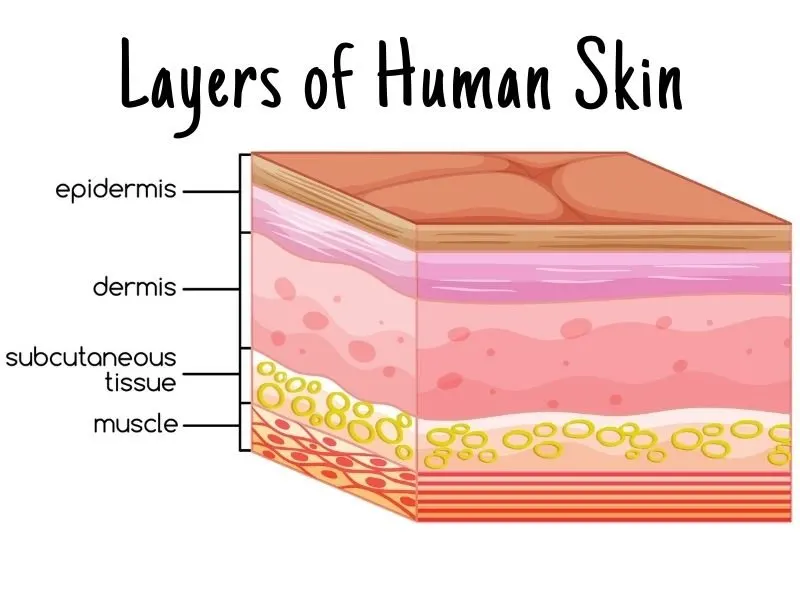
The dermis is located beneath the epidermis, so the study indicated that the higher 12% lactic acid was able to penetrate the skin better than the 5% lactic acid concentration.
FAQs
The Ordinary Lactic Acid serums can be used with water-based niacinamide serums like The Ordinary Niacinamide 10% + Zinc 1%. Niacinamide provides additional skin barrier support, making it a great choice to pair with lactic acid.
The Ordinary lactic acid serums are leave-on products and should not be washed off the skin.
Apply a product after The Ordinary lactic acid that complements its formula, like skin-barrier protecting The Ordinary Niacinamide 10% + Zinc 1% or hydrating The Ordinary Hyaluronic Acid 2% + B5.
The Ordinary lactic acid serums should be used no more than once a day. A few times a week will be optimal for most.
Yes, you can use The Ordinary lactic acid serums with The Ordinary Hyaluronic Acid 2% + B5. These serums work well together, as the hyaluronic acid will replenish hydration and moisture, and support a healthy skin barrier.
Using retinol and lactic acid together can cause irritation and redness. Additionally, the variance in pH between alpha hydroxy acids like lactic acid and retinol may compromise product effectiveness. Consider using The Ordinary lactic acid serums and The Ordinary retinol/retinoids on different days or times of the day.
Related Posts:
- Best Azelaic Acid Products
- The Ordinary Anti-Aging Skincare Review
- The Best The Ordinary Products for Wrinkles and Mature Skin
- The Best The Ordinary Products for Dry Skin
- The Best The Ordinary Skincare Products for Oily & Acne-Prone Skin
- The Best The Ordinary Products for Hyperpigmentation and Dark Spots
- How To Use The Ordinary Glycolic Acid
Final Thoughts on The Ordinary Lactic Acid Serums
Even though these The Ordinary lactic acid serums are affordable and provide noticeable results, in general, The Ordinary suggests indirect (non-acid) forms of facial exfoliation instead of direct acids due to potential inflammation and sensitivity from acid use.
If you are interested in indirect forms of exfoliation, please check out The Ordinary’s sister brand NIOD’s Non-Acid Acid Precursor.
Still, I think that if you are looking for mild peeling formulations for under $10 each, these lactic acid chemical exfoliants from The Ordinary are some of the best available.
Thanks for reading!

